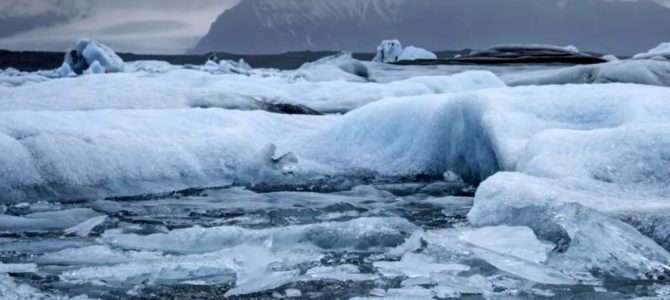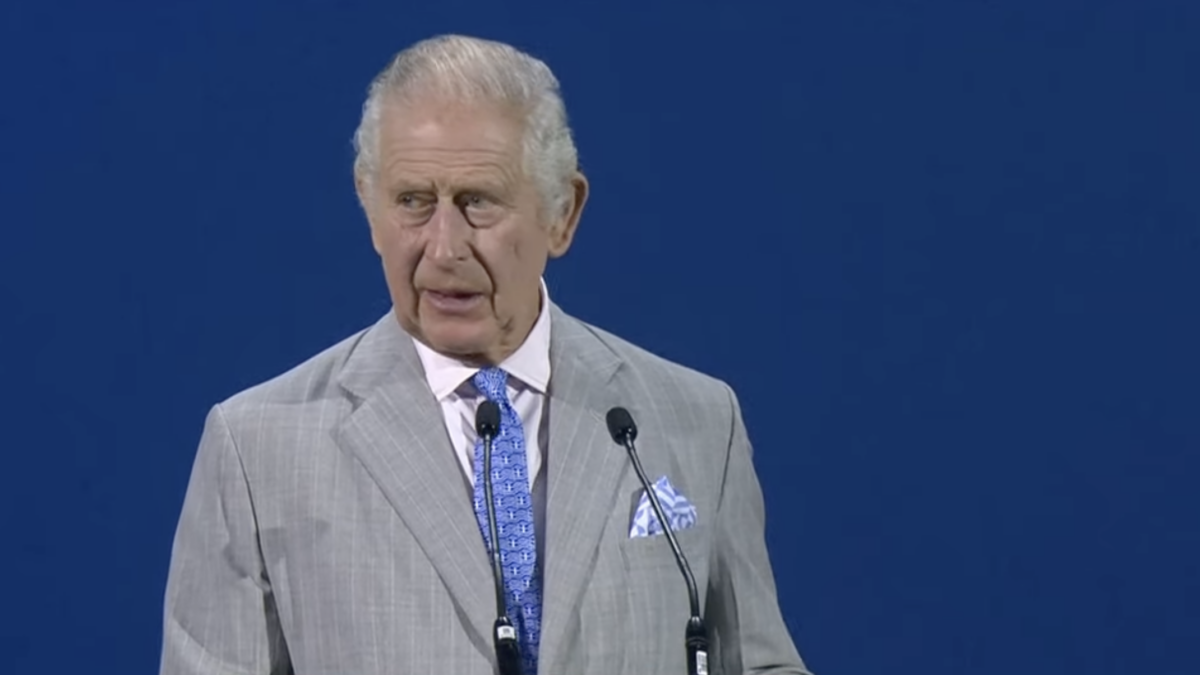
Leonardo DiCaprio returns, not as a starring actor, but as producer and narrator of a new climate documentary. “Ice on Fire,” now available through HBO, covers what director Leila Conners and her team view as the existential “climate crisis” facing our planet.
The documentary presents its case for how “climate disruption” threatens the earth, then offers what it sees as viable solutions to stem the tide. Make no mistake, however, the message of “Ice on Fire” is a desperate plea. DiCaprio emphatically intones that we need “100 percent renewable energy now.”
The Few Virtues of ‘Ice on Fire’
It’s a slick documentary. Graphics are casually integrated to the presentation, superimposed over the live-action footage with clean, sans serif Helvetica-style typefaces. The runtime is also viewer friendly. Clocking in at around 95 minutes, the documentary doesn’t lag or feel like a chore to watch.
By not overstaying its welcome, the film almost necessitates that the viewer looks into the things DiCaprio had discussed once the credits start to roll. The rushed nature of some segments invites further exploration. There will be more than a few people Googling “biochar” and “carbon capture machine” after the film ends.
“Ice on Fire” is beautifully scored by Jeremy Soule, most famous for providing the music for the game “Skyrim” back in 2011. Soule’s musical cues combined with images of snow-frosted pines will elicit nostalgia for those familiar with Bethesda’s “Elder Scrolls” series of role-playing games. One inadvertent result of the documentary may not be an increase in climate activism, but gamers returning to Tamriel for another playthrough.
Not wanting to come off as another tired sequel to “An Inconvenient Truth,” “Ice on Fire” ditches the typical approach of a PowerPoint laden TED-talk and wisely minimizes narration. Environmentalists and climate scientists do most of the talking. Some of the highlighted scientists resonate, and their calls for action seem at least partially objective. Others clearly have an agenda and slip into grandiose hyperbole. More on that later.
According to DiCaprio, We’re in Big Trouble
The crux of the film’s message is simple: we are emitting too much carbon, creating a “climate disruption” we must fight immediately or face dire consequences. Although “global warming,” “climate change,” and other phrases are used to describe what the film heralds as a clear and present danger, “climate disruption” is the term DiCaprio uses most frequently. It’s the sort of buzz-phrase that sounds like it’s gone through thousands of dollars of poll testing and focus group responses to get just right.
It’s hard to dispute evidence that human beings have released a lot of CO2 into the atmosphere during the last 250 years. That this has affected the planet is also a safe bet. Where there is still debate—whether DiCaprio and his supporters want to recognize it or not—is over how much is attributable to mankind, and what will the planetary impact be if we stay on this course?
“Ice on Fire” purports to have a definitive answer to the final question. Spoiler alert: it’s not good. The conclusion the film reaches is that continuing on our present path of CO2 emissions will lead to “catastrophic” results.
The Film’s ‘Impartial Experts’ Are Anything But
DiCaprio tells the audience early on that a voice must be given to “impartial experts.” He then provides a mouthpiece to a wide host of scientists that are the exact opposite. One scientist predicts permanent droughts, less land, less food, and less water—all while horrifying graphics depict the flooding of coastal cities. Nearly all of Florida, London, Shanghai, and the majority of the U.S. East Coast are shown completely overtaken by water. No timeline or predictive date is shown, which is certainly convenient.
In the next sequence, scientist Jim White claims that once we start emitting between 600-700 parts per million of atmospheric CO2, we will see the end of all land ice on the planet and a 252-foot rise in the sea level. “Ice on Fire” estimates the current level of CO2 to be at around 400 ppm, with an average increase of 2 ppm each year. Using these figures, it would take around 125 years to get to the ice extinction White foretells, not accounting for new research suggesting Arctic sea ice may be expanding.
Biologist Janine Benyus bluntly states, “It’s gonna get crazy!” One scientist advocates for a vague, yet ominous, “reorganization of human activities.” Another says fossil fuel companies are “literally profiting off the death of life on earth,” and that some “climate denial” rises to the level of a “crime against humanity” that should be prosecuted at the Hague. These are the “impartial” folks DiCaprio mentioned.
Removing Carbon from the Atmosphere
To avert “dangerous climate change,” energy economist Ottmar Edenhofer states that we must produce zero C02 emissions by 2050, and negative emissions after that. The goal? Return CO2 levels to where they were before the Industrial Revolution. This is a tall order, to say the least. It also, however, leads to one of the more interesting parts of the documentary.
An increase in the stock of Redwood trees, oysters, marine snow, underwater forests of kelp, and innovations like “biochar” can sequester or remove carbon from the atmosphere. All of these are promising and worthwhile endeavors.
However, new machines designed for direct air capture of CO2 are still wildly inefficient, expensive, and impractical. To capture just 1 percent of CO2 emissions, the founder of Climeworks estimates it would take 300,000 duplicates of his carbon capture plant in Zurich. “Which, of course,” he deadpans, “is a very high number.” Indeed.
Leo opines that “climate disruption” has led to an increase of more “severe” and “intense” storms. One voice-over states that “natural disasters are so common now!” The film goes on to specifically link the 2018 California wildfires to “climate disruption”—a dubious claim at best.
Calfornia’s wildfires are not a new phenomenon. As The Federalist helped elucidate last year, “climate change” should not be blamed for the wildfires, and it was government mismanagement and environmentalism that made the situation worse.
Alarmism and Dubious Proposals Hurt the Film
Leo’s documentary is stoic in its delivery, but the actual text of its script is short on subtlety, nuance, or balance. Less than two minutes into the film, DiCaprio narrates that mankind has “triggered multiple climate tipping points that threaten the very existence of life on earth.” DiCaprio warns that “the clock is ticking” and that we must impose radical solutions “immediately.” A fisherman opines, “There’s gonna be no food, [and] no jobs on a dead planet.”
The imagery used is similarly alarmist. There are montages featuring skinny and starving polar bears, dried-up goats in the middle of parched landscapes, and even one shot of a giant pile of dead whales.
A carbon “drawdown” chart lists actions that the documentary’s scientists believe will help achieve an emissions-free world. The list features some questionable suggestions, to put it mildly, putting forth solutions like “refrigerant management,” “plant-rich diet,” “family planning,” and “rooftop solar.” The most puzzling solution on the list is “educating girls.” How “educating girls” relates to climate the documentary does not explain. It would also help if Leo lowered his own massive carbon footprint a little bit.
Towards the end of the film, methane release from the underneath the Arctic is purported to be an apocalyptic-level threat. However, the scientists who discuss it in the documentary admit they don’t know exactly where the methane is coming from, why it’s increasing now, and how it will affect the climate if it continues. The whole ten-minute sequence isn’t sufficiently developed and poses more questions than it answers. It comes off like an odd last-minute addition to a film already burdened with a fair share of doomsday predictions.
Nothing to Say on Nuclear Power?
Finally, despite the film’s statement that “we have to explore all of our options,” nuclear energy isn’t mentioned once. The closest we get is a throwaway line when a scientist lists “solar, wind, etc.” as fossil fuel alternatives. Running time couldn’t have been the issue, since “et cetera” and “nuclear power” both contain four syllables. So, what gives?
France, where DiCaprio unveiled his film this spring at the Cannes Film Festival, is the largest user of nuclear-generated energy in the world. In 2018, France derived a whopping 71.6 percent of its electricity from nuclear power. As professor Joshua Goldstein pointed out on The Federalist Radio Hour, we now know that nuclear power is extremely safe. Recent projections also foresee a time when newer forms of nuclear power could potentially provide unlimited, cheap energy.
The film’s deafening silence on nuclear power as a solution to “climate disruption” is likely the fact that it doesn’t fit with the left’s environmentalist agenda. More funding for nuclear energy construction or research means less money for the left’s pet projects of solar and wind. This is an unfortunate, glaring omission in the film—one that would have balanced DiCaprio’s narrative and given the film’s proposals and statements increased authenticity.
Proponents of dramatic proposals like the Green New Deal will doubtless contend the documentary doesn’t go far enough. Those still on the fence about what do to about our climate will likely be turned off by its fearmongering tactics—such as a line during the final minutes that we’re going to “drown, burn, and starve ourselves to death.”
DiCaprio’s polished “Ice on Fire” makes some constructive points, especially concerning the need for ways to sequester or remove CO2 from the atmosphere. While many environmentalists will fail to acknowledge the free-market capitalism that has made innovations like direct air carbon capture possible, it’s at least refreshing to see a climate documentary argue for more technology instead of seeking to return us to the Stone Age. Ultimately, however, the film is overwrought with hysterical proclamations and politically driven agendas that blunt the effectiveness of its premise.









